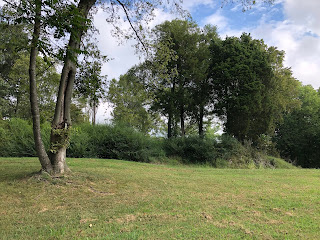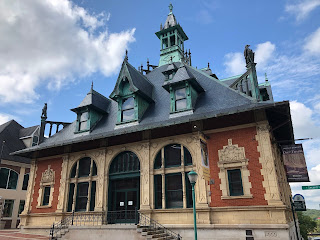 |
| Miniature Train display at Clarksville's Customs House Museum |
Our stopover in Clarksville, Tennessee, brought to mind this song by The Monkees, that wanna-be-the-Beatles band of the 1966-1968 television show.
"Take the last train to Clarksville
And I'll meet you at the station
You can be there by four-thirty
'Cause I've made your reservation,
Don't be slow
Oh, no, no, no
Oh, no, no, no"
The final line of the lyrics is a mournful, "And I don't know if I'm ever coming home." Well, I do know that I'm coming home. Tim and I are en route to the farm in Kansas where corn is standing tall in the fields waiting to be harvested. We'll be there until November to harvest not only corn but soybeans as well. Yet, on our way we took two days to see the historic city of Clarksville, Tennessee.
As the Civil War moved closer, Clarksville, with its 5,000 inhabitants, was considered a prize for the Union Army because of its location on the Cumberland River, its steamboat landings and railroad crossing, plus its iron works which were capable of producing small arms, cannon and shells. Clarksville and the Confederate defense at Fort Defiance were critical to stopping federal forces from reaching Nashville.
When Union iron-clad gunboats steamed toward the town, city leaders decided that a wiser course would be surrender. Thus, the fort was taken without a shot being fired.
Little remains of Fort Defiance today. Its earthworks are slowly being reclaimed by nature as you can see below, but the Fort Defiance Interpretative Center's exhibits explain its importance.
Union control of the Mississippi and its tributaries meant control of North America and guaranteed victory of the war. With so much riding on this key location, Tim and I felt our stop at the interpretative center to learn more about Clarksville's history was well-worth our time.
We also enjoyed our stroll along the downtown's scenic McGregor Park Riverwalk beside the Cumberland River. The river's east-west course with its connection to the Ohio and Mississippi rivers made Clarksville an important link for shipping goods from Pennsylvania to New Orleans.
Today, as we saw, barges still float goods along its waterway.
The Customs House Museum and Cultural Center is another must-see. The beautiful building built in 1898 was once a post office and also a customs house created in response to the area's huge tobacco trade. Now it tells the story of the city and nearby Fort Campbell, home of the 101st Airbourne Division which its first commanding general, Major General William C. Lee, said "had a rendezvous with destiny." Certainly the Division has played a role in every war since World War II and is still vital to our nation's defense today.
Before we left town, we hiked a portion of the Clarksville Greenway, a 6-mile trail that follows an abandoned railroad bed. The greenway meanders along a creek underneath a canopy of hardwood trees. With outcroppings of rock, it's a pretty place to work off pounds.
However, a text from my brother Jon told us he has started to pick corn. So--
"Don't be slow!
Oh, no, no, no!
Oh, no, no, no!"
Postscript:
Tim and I arrived at the farm two weeks ago but with all the hubbub, I laid aside this last installment until now. We're here until November. Thanks for following our travels!








I am sure Jon and your dad are glad you're here. All hands on deck!
ReplyDelete